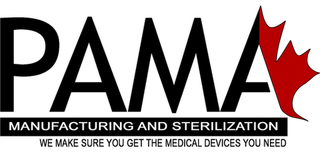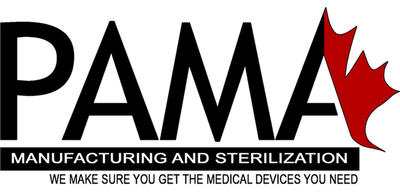
PAMA Manufacturing and Sterilization
The solution to the ethylene oxide crisis
We have the solution to the ongoing issue reported in last year’s magazine, ''what's the solution to the ethylene oxide crisis?''
Ethylene oxide (EtO) is a gas typically used for sterilization in the medical device industry since 1930. Like any hazardous gas, if mishandled, the gas can have a detrimental effect on the environment and health of those exposed. For that matter, it should be handled with extreme caution. PAMA Manufacturing and Sterilization -- operating in Quebec, Canada since 2012 -- spearheaded the effort to build an eco-efficient, safe and cost-effective EtO sterilization process.
DISCOVER PAMA’S PIONEER
ETHYLENE OXIDE STERILIZATION
E t O S T E R I L I Z A T I O N
PAMA INNOVATION
01
ECO-EFFICIENT
PAMA Manufacturing and Sterilization developed a scientific solution that reduces EtO emissions from the typical EtO sterilization process.
PAMA's engineering team rendered the process more efficient by using less EtO gas to achieve the same sterilization results.Effectively, subsiding negative environmental impacts. For instance, the process uses 50% less EtO gas for each sterilization cycle.
The newly engineeredprocess handles EtO responsibly, then recycles it. Thanks to the enclosed nature of the system, the process sends any consumed EtO to an in-house scrubber responsible for the removal of harmful material. This prevents the direct release of ETO into the environment.
PAMA EtO PROCESS
EtO (MG/L)
PAMA reduces the dispersion of toxic waste by recycling EtO gas into ethylene glycol. This recycled material is then repurposed into a new set of products, such as plane defroster and windshield washer.
Furthermore, additional strategies are used to reduce environmental impact, such as a renewable source of energy provided by Hydro-Quebec to power its manufacturing and sterilization plant.
02
SAFE
PAMA complies with the two voluntary consensus standards for ethylene oxide sterilization - ANSI AAMI ISO 11135:2014 and ANSI AAMI ISO 10993-7:2008(R)2012.
Extra safety measures are implementedto monitor EtO levels across its manufacturing facility. In fact, every operator and mechanical room is equipped with a EtO detector.
To confirm the process operates as intended, PAMA voluntarily measures twice a year its EtO environmental emissions, using a third party for unbiased results.
03
COST-EFFECTIVE
PAMA automates its entire process which reduces the sterilization cycle time to 14 hours including preconditioning, conditioning, exposure and aeration time.
They also implement a parametric release system, which eliminates the usage of biological indicators for product release. That process saves 7 days of release time.
EtO industry
Although medical devices can be sterilized by several methods, EtO has been the most common method of sterilization of medical devices. It is a well established and scientifically proven method of preventing harmful microorganisms from reproducing and causing infections and has many advantages. The process is convenient, affordable, effective and above all does not degrade medical devices, as some other sterilization processes do.
Medical devices made from plastic or resin polymers, metals, or glass—or devices that have multiple layers of packaging or hard-to-reach crevices—are likely to be sterilized with ethylene oxide to avoid product damage during the process. These include surgical kits used in emergency procedures and routine procedures such as cardiac surgery and hip or knee replacement surgeries.
About PAMA
Disrupting the industry by greening the sterilization process for medical devices is only one of many areas in which PAMA is focused and continue to lead the industry in developing new techniques to green processes and reduce waste in the medical device field.
PAMA is looking for partnerships to expand their sterilization capacity rapidly. This presents a massive challenge as, at its peak, EO was used on about 50% of healthcare products in the United States — or more than 20 billion medical products per year1.
1(October 25, 2019). Norman E. "Ned" Sharpless, MD Acting Commissioner of Food and Drugs - Food and Drug Administration. Statement on concerns with medical device availability due to certain sterilization facility closures, from www.fda.gov/news-events/press-announcements
Back To Top
